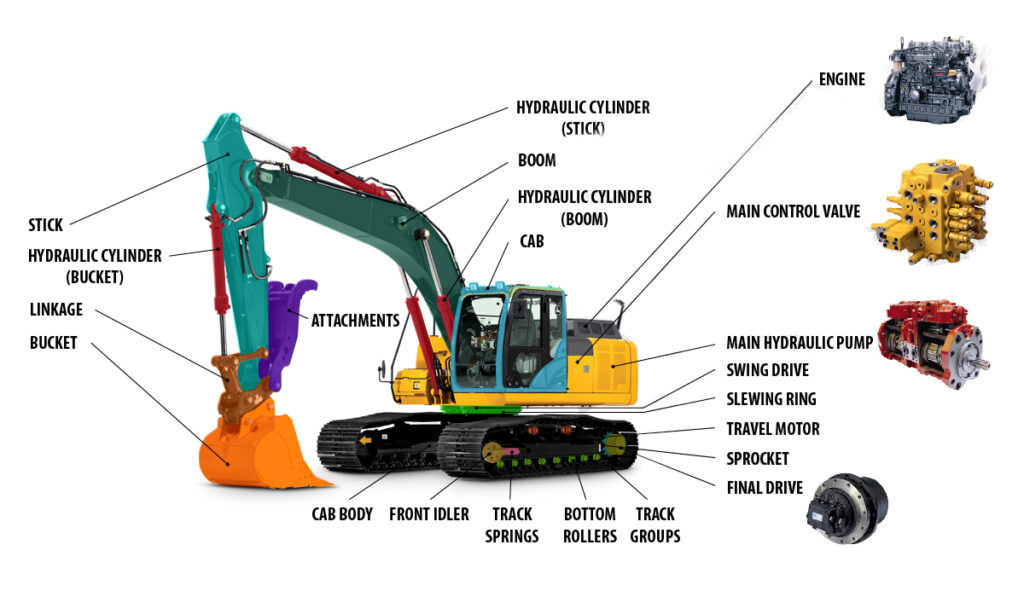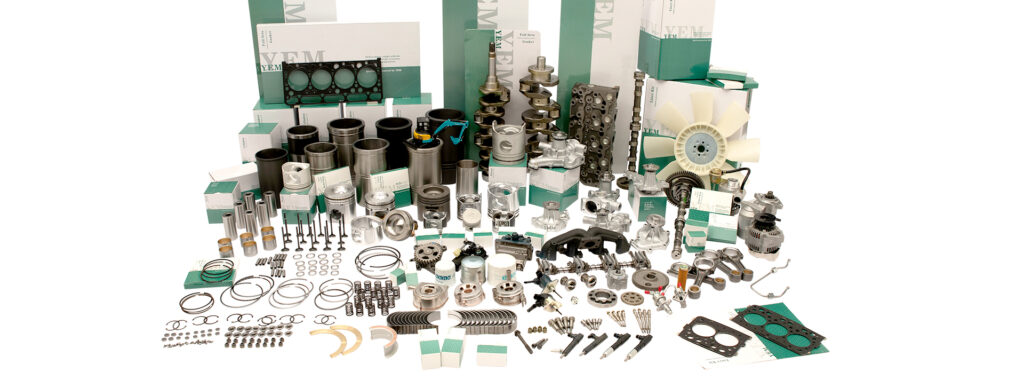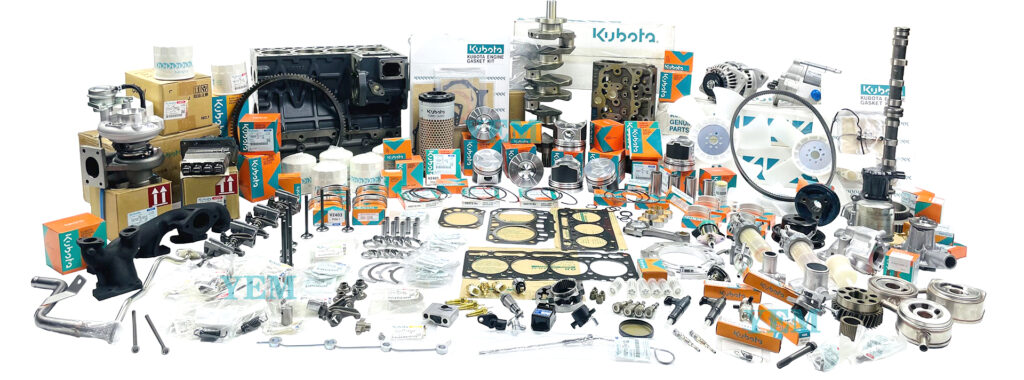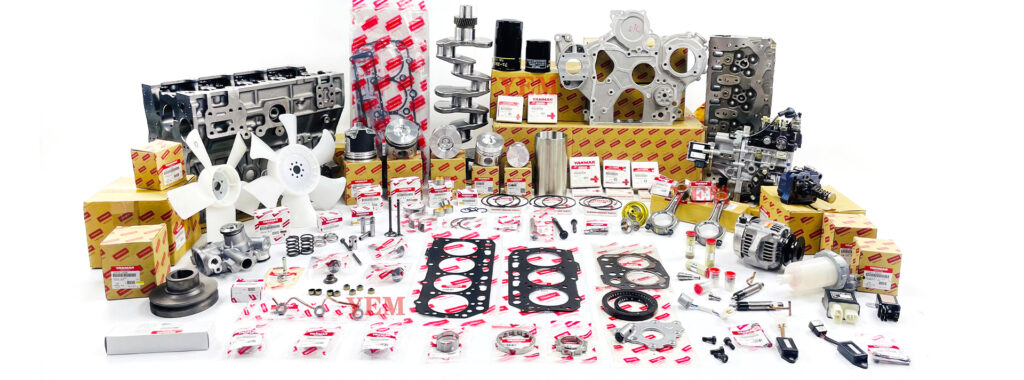An Overhaul Rebuild Kit is a collection of tools and parts used to perform an engine overhaul. It contains a list of parts that need to be replaced or repaired to restore the engine’s performance and reliability.
Engine overhaul is usually a repair process performed when an engine is severely malfunctioning, worn or aged. This may involve disassembling the engine and inspecting the condition of individual components, then repairing or replacing as necessary.

Overhaul Rebuild Kits typically include the following parts:
Piston assembly: including piston, piston ring and plug pin. These pieces are responsible for creating air pressure and pushing the products of combustion into the cylinder.
Crankshaft Assembly: Includes crankshaft, connecting rod and connecting rod bearings. These components are responsible for converting the up and down motion of the piston into rotary motion and transmitting power to the transmission system.
Cylinder and Piston Rings: The cylinder liner is the sleeve that fits inside the cylinder, while the piston rings sit on the piston. Together, they form a seal that prevents leakage of combustion products and provides a seal for lubricating oil.
Valves and Valve Guides: The valves control the rate at which gas enters and exits the cylinder. The valve guides guide the movement of the valves.
Water pump and oil pump: The water pump is responsible for circulating the coolant, and the oil pump is responsible for supplying lubricating oil to various parts of the engine.
Seals and Gaskets: These parts are used to ensure the tightness between the various parts of the engine to prevent the leakage of liquid and gas.
With the Overhaul Rebuild Kit, critical components in your engine can be replaced or repaired to restore performance and reliability. Helps extend the life of your engine and keep it running properly. However, engine overhaul is a complex task and it is recommended that it be carried out by experienced and professional technicians.
An Overhaul Rebuild Kit is a kit used to perform a complete repair of an engine or other mechanical equipment. It usually contains all necessary parts, parts, gaskets, shafts and other consumables, as well as critical components that may need to be replaced.

The following are the general steps when using the Overhaul Rebuild Kit for repairs:
- Ready for the job: Make sure you have the correct tools and equipment, and perform repairs in a safe environment. Read the relevant technical manuals and instructions to understand the disassembly and assembly procedures for specific equipment.
- Disassembly: Disassemble the equipment that needs to be repaired to the parts that need to be replaced. This may involve dismantling the casing, exhaust pipe, air pipe, transmission system, etc.
- Cleaning and Inspection: Thoroughly clean the disassembled parts and carefully inspect them for wear. Cleaning can be done with appropriate detergents and tools as required.
- Replace parts: Replace the parts that need to be replaced one by one according to the instructions provided by the Overhaul Rebuild Kit. Be sure to use the correct size and type of parts and install them according to the manufacturer’s recommendations.
- Assembly: Reassemble the replaced parts into the equipment. Make sure that all bolts, nuts and other connections are properly installed and tightened.
- Test and adjustment: After the assembly is completed, carry out necessary tests and adjustments. This may include starting the standby and checking its health, adjusting relevant parameters to ensure proper operation.
Note that the specific repair techniques for the Overhaul Rebuild Kit may vary by device and manufacturer. Therefore, it is best to refer to the relevant technical manuals and guides and follow the manufacturer’s recommendations and instructions before undertaking repairs.
If you have a repair question with a specific device or engine, please provide more details and I will try to provide more accurate help.

Choosing an Overhaul Rebuild Kit to repair your engine is a wise decision as it provides all the parts and components you need to ensure a complete engine restoration. Here are some suggestions for choosing an Overhaul Rebuild Kit:
- Determine your engine model and specification: First, you need to determine your engine model and specification. This will help you find an Overhaul Rebuild Kit that exactly matches your hair dryer. You can obtain this information by consulting your engine’s owner’s manual, your vehicle’s registration, or a qualified technician.
- Choose a Reliable Supplier: It is very important to choose a reliable supplier to ensure you get a high quality Overhaul Rebuild Kit. Look for experienced and reputable suppliers, and check their customer reviews and feedback. Also, make sure the supplier offers a kit for your specific engine model.
- Check Kit Contents: Before purchasing, double-check the contents of the Overhaul Rebuild Kit. Make sure the parts include all the critical parts you need such as pistons, pistons, crankshaft bearings, valves, valve guides. Also make sure that all parts in the kit meet original equipment manufacturer (OEM) specifications.
- Consider price for quality: Although price is an important factor, don’t just look at price and ignore quality. Selecting a mass of zero ensures engine reliability and durability. Compare prices from different suppliers and balance price against quality.
- Seek professional advice: If you are confused about choosing the right Overhaul Rebuild Kit, you can consult our professional technicians or experienced mechanics, we can provide valuable advice according to your physical conditions and needs, and help you do make wise decisions.
In short, choosing the right Overhaul Rebuild Kit is very important to successfully repair the engine. By doing your research, selecting a reliable supplier, and considering factors such as quality and price, you can find the best package for your engine.
Installing the Overhaul Rebuild Kit requires certain expertise and skills. The following are general installation steps, but please note that individual models and engines may vary, so it is recommended to refer to the relevant vehicle manufacturer’s guide or consult a professional auto mechanic.
- Preparation:
- Make sure you have the correct Overhaul Rebuild Kit, including all required replacement parts.
- Prepare the required tools, such as hands, screwdrivers, hands, etc.
- Remove the engine:
- Take the engine out of the car and place it on a suitable bench.
- Disassemble the external parts of the engine, such as intake, exhaust pipe, cooling system, etc.
- Disassemble the parts of the engine section, such as pistons, connecting rods, crankshafts, etc.
- Clean and inspect:
- Carefully clean all disassembled parts making sure they are free from any dirt or damage.
- Perform a thorough inspection of all components, especially related parts such as piston rings, crank bearings, etc., to ensure they are within specification.
- Replacement parts:
- According to the guide provided by the Overhaul Rebuild Kit, replace the parts that need to be replaced one by one, such as plugs, piston rings, crank bearings, etc.
- Be sure to install each part correctly and tighten the bolts and nuts to the specified torque.
- Group engine:
- Reassemble the replaced parts to the engine, making sure they fit correctly and fit well with the other parts.
- Reinstall external components such as air intake, exhaust pipes, cooling system, etc. in accordance with the specifications and order of manufacture.
- Test and adjust:
- Perform necessary tests and adjustments after engine assembly. This may include compression testing, ignition system adjustments, and more.
- Make sure the engine is running and check for any unusual noises or leaks.
Please note that the above steps are general guidelines only and specific installation procedures may vary by model and engine type. If you do not have enough experience and skills, it is recommended to seek the help of a professional auto mechanic to ensure that the installation process is correct.

The maintenance and maintenance of the Overhaul Rebuild Kit is one of the key steps to ensure the performance and reliability of the equipment. Here are some common maintenance and care recommendations:
- Periodic inspection: According to the manufacturer’s recommendations, regularly inspect the equipment and perform necessary maintenance. This can include checking the level and quality of lube oil coolant, drivetrain and other critical components.
- Replace worn parts: Use the parts provided in the Overhaul Rebuild Kit to replace worn or old parts. May include seals, gaskets, shafts, etc. Follow the manufacturer’s guidelines and recommendations to ensure proper installation and adjustment of your new unit.
- Cleaning and Lubricating: Clean equipment regularly and lubricate according to manufacturer’s recommendations. Use appropriate cleaners and lubricants, keep equipment surfaces clean, and add or change lubricants as needed.
- Adjustment and Calibration: The equipment must be adjusted and calibrated according to the manufacturer’s guidelines. This may involve adjusting the drivetrain, calibrating sensors, or adjusting other key components.
- Record maintenance history: Keep detailed maintenance records including maintenance date, maintenance content and replaced parts. This helps track the maintenance history of the equipment and provides a reference for future maintenance planning.
Please note that specific maintenance and maintenance requirements may vary by equipment type, manufacturer and conditions of use. It is recommended that you refer to the maintenance manual provided by the equipment manufacturer or consult a qualified technician for the schedule of specific maintenance procedures that apply to your equipment.
An Overhaul Rebuild Kit is a kit used to perform an engine overhaul, and it usually contains a series of parts that need to be replaced or repaired. Here are some common issues you may encounter when using the Overhaul Rebuild Kit:
- Mismatched parts: Sometimes some parts in the kit may not match your motor model or specification. Before purchasing pieces, always confirm that the kit is compatible with your engine and that all pieces are the correct specifications and sizes.
- Installation difficulties: Engine overhaul usually requires a certain amount of technical knowledge and experience. If you have no relevant experience, it is recommended to ask a professional mechanic or technician to complete the installation. They can ensure that the individual parts in the kit are installed correctly and avoid potential problems.
- Damaged or missing parts: During shipping or storage, parts of the kit may be damaged or lost. Before starting installation, carefully check all parts in the kit to make sure they are intact and nothing is missing.
- Doesn’t solve the root problem: Initiating an overhaul is only one way to solve engine problems, but it may not solve all problems. If there are other problems with your engine, repairs alone may not fix them all. Before an overhaul, it is best to perform a complete inspection and diagnosis of the engine to determine whether there are other parts that need to be repaired or replaced.
- Quality Issues Occasionally, pieces in a kit may have quality issues, such as manufacturing defects or acceptable materials. If you encounter such a problem, it is recommended to contact the supplier for a return or to obtain appropriate support.
Please note that Overhaul Rebuild Kit specifics and FAQs may vary by engine model and supplier. Before purchasing and using the kit, it is best to refer to relevant documents, guides or consult professionals to ensure the correct use and installation of the kit.
Our YEM team is dedicated to providing you with the best possible service and support. If you have any questions or need assistance, please don’t hesitate to reach out to us.
We are here to help and look forward to assisting you with any inquiries you may have.
